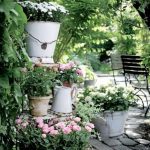Are you looking for ideas for long narrow gardens that will maximize your space and create a beautiful outdoor oasis? Long, narrow gardens present unique challenges but also offer great potential for creativity and innovative design.
In this article, we will explore various strategies and techniques to make the most of your long narrow garden, from vertical gardening to creating optical illusions. With the right approach, you can transform your challenging space into a stunning and functional garden that you can enjoy year-round.
One of the key considerations when designing a long narrow garden is how to maximize the available space. Vertical gardening is an effective way to make use of the height of your garden, utilizing trellises, arbors, and climbing plants to add greenery without taking up precious ground space. Additionally, pathways and walkways can be strategically designed to create a sense of depth and illusion of space, making your garden feel larger than it actually is.
Beyond maximizing space, zoning and dividing are important concepts to consider in long narrow gardens. By using a combination of plants and hardscaping elements, you can create distinct areas within your garden that serve different purposes or have their own unique aesthetic. These zones can help break up the length of the garden and add visual interest. Stay tuned as we dive deeper into these ideas and more throughout this article.
Vertical Gardening
Long, narrow gardens present a unique set of challenges for landscaping and design. However, they also offer an opportunity to create a visually stunning and functional outdoor space. One of the key elements in maximizing the potential of a long narrow garden is vertical gardening. By utilizing trellises, arbors, and climbing plants, it is possible to make the most of the limited space available while adding visual interest and dimension.
Trellises and Arbors
Trellises and arbors are essential components of vertical gardening in long narrow gardens. These structures not only provide support for climbing plants but also add an architectural element to the garden. Whether placed along the length of the garden or used to divide different zones within it, trellises and arbors can help create a sense of height and depth in what may otherwise feel like a cramped space.
Climbing Plants
Selecting the right climbing plants is crucial for vertical gardening in long narrow gardens. Vines such as clematis, jasmine, or wisteria can be trained to grow on trellises and arbors, adding bursts of color and fragrance throughout the garden. Additionally, using tall grasses or ivy can help soften hard boundaries and transition from one area to another within the long narrow space.
Maximizing Space
Incorporating vertical elements not only adds visual interest but also maximizes valuable ground space in long narrow gardens. By encouraging plants to grow upwards rather than outwards, more room is left for other features such as seating areas, pathways, or even small water features. Vertical gardening offers endless possibilities for creating both beauty and functionality in long narrow gardens.
Pathways and Walkways
One idea for long narrow gardens is to use curved pathways to visually break up the length of the garden. Curved paths can create a meandering effect, leading the eye along the garden and giving the impression of a larger space. Additionally, using different materials for pathways such as gravel, stepping stones, or wood chips can add texture and visual interest.
Another strategy for creating a sense of depth is through the use of pergolas or arches over pathways. These structures not only provide support for climbing plants but also divide the garden into distinct areas, adding layers to the space. By breaking up the view into smaller segments, pergolas and arches can make a long narrow garden feel more spacious.
Lastly, incorporating focal points along pathways such as sculptures, ornamental trees, or seating areas can draw attention away from the narrowness of the garden. Placing these focal points strategically along the pathway will encourage visitors to pause and take in different views, allowing them to appreciate the full length of the garden.
| Elements for Pathways | Benefits |
|---|---|
| Curved paths | Create meandering effect and give impression of larger space |
| Pergolas or arches | Add layers to the space and divide garden into distinct areas |
| Focal points | Draw attention away from narrowness and encourage appreciation of full length |
Zoning and Dividing
Long narrow gardens can present a unique set of challenges when it comes to creating distinct areas within the space. However, with some creative thinking and strategic planning, it is possible to divide the garden into different zones to maximize its potential. Whether you want a separate dining area, a relaxing lounge space, or a play area for kids, zoning and dividing techniques can help you achieve these goals.
Using Plants as Natural Dividers
One effective way to create distinct areas within a long narrow garden is by using plants as natural dividers. This can be achieved through the use of hedges, shrubs, or even tall grasses to delineate different spaces. For example, planting a row of tall bushes or ornamental grasses can create a barrier between a dining area and a relaxation space, providing privacy and defining each zone.
Integrating Hardscape Elements
In addition to using plants, hardscape elements such as pergolas, trellises, or decorative screens can also be used to divide the garden into different areas. These structures not only provide visual separation but also add architectural interest to the garden. For instance, placing a trellis with climbing vines can create an intimate seating area within the garden while adding vertical visual appeal.
Combining Greenery and Structures
To maximize the effectiveness of zoning and dividing in a long narrow garden, consider combining both greenery and structures. By incorporating a mix of plants and hardscape elements, you can create an engaging and functional outdoor space that serves various needs. For example, you could combine tall potted plants with lattice panels to create a cozy reading nook or meditation spot within the garden.
Illumination
For long narrow gardens, strategic lighting can play a crucial role in creating an inviting and visually appealing outdoor space. By carefully choosing and placing lighting fixtures, you can highlight the length of the garden and make it feel more spacious. One popular technique is to use uplighting to illuminate trees or tall plants along the garden’s borders, drawing the eye upward and emphasizing the vertical elements of the space.
In addition to uplighting, consider incorporating pathway lighting to define walkways and create a sense of depth. This not only enhances safety during evening hours but also adds visual interest and dimension to the garden. Another idea is to use string lights or lanterns along fences or trellises, providing soft ambient light that creates a cozy and charming atmosphere.
It’s important to strike a balance between functional lighting and decorative elements in a long narrow garden. While illuminating key areas, such as seating areas or focal points, try to avoid overwhelming the space with too many lighting fixtures. Opt for energy-efficient LED lights and consider installing timers or motion sensors for added convenience and energy savings.
Incorporating strategic lighting into your long narrow garden design can transform it into a versatile and enchanting outdoor living space, perfect for relaxing or entertaining day or night.
| Strategic Lighting Techniques | Benefits |
|---|---|
| Uplighting | Emphasizes vertical elements |
| Pathway Lighting | Defines walkways and adds dimension |
| String Lights/Lanterns | Creates a cozy atmosphere |
Focal Points
When designing a long narrow garden, it’s important to create visual interest and draw the eye along the entire length of the space. One effective way to achieve this is by strategically placing focal points throughout the garden. Here are some ideas for incorporating focal points in a long narrow garden:
- Sculptures or art pieces: Adding sculptures or art installations can create a sense of intrigue and draw attention along the length of the garden.
- Ornamental trees or shrubs: Planting ornamental trees or shrubs at key points can provide visual interest and help break up the linear nature of a long narrow garden.
- Architectural elements: Incorporating architectural features such as arbors, pergolas, or even an outdoor fireplace can serve as focal points and create different zones within the garden.
In addition to adding visual interest, these focal points can also help create a sense of movement and flow within the garden, leading visitors on a journey through the space. By carefully choosing and placing these elements, it’s possible to transform a long narrow garden into an inviting and visually appealing outdoor oasis.
Container Gardening
When it comes to container gardening in long narrow gardens, it’s essential to choose plants that will thrive in the specific conditions of your garden. Consider the amount of sunlight that different areas of your garden receive throughout the day and choose plants accordingly. Additionally, pay attention to the size of the containers you use, making sure they are proportionate to your garden and allow for proper drainage.
One creative idea for long narrow gardens is to use a variety of differently sized and shaped containers to create visual interest. You can mix and match different textures and colors to create a diverse and dynamic display along the length of your garden. This not only adds visual appeal but also helps in breaking up the monotony of a long narrow space.
With some creativity and careful planning, container gardening can be an excellent way to bring life and vibrancy to long narrow gardens without sacrificing precious ground space. By utilizing pots and planters strategically, you can make a big impact on your outdoor space.
Mirror and Optical Illusions
When dealing with a long narrow garden, it can be challenging to make the space feel open and inviting. However, by using mirror and optical illusions, it is possible to create the illusion of width in a narrow space. One effective way to achieve this is by incorporating reflective surfaces such as mirrors, metallic accents, or even stainless steel sculptures. These elements can help bounce light around the garden, making it appear larger than it actually is.
Another design trick to create the illusion of width in a long narrow garden is to use bold and diagonal lines. This can be achieved through the use of pathways or hardscape features such as decking or paving stones. By angling these elements across the length of the garden, it can create a sense of movement and depth, making the space feel more expansive.
In addition to using reflective surfaces and bold lines, incorporating optical illusions such as geometric patterns or trompe l’oeil murals can also help create a visual trick that makes the garden appear wider. By strategically placing these design elements within the landscape, it can draw the eye along the length of the garden and make it feel less constrained.
These techniques are just a few examples of how mirror and optical illusions can be utilized to enhance long narrow gardens and make them feel more spacious and inviting.
Water Features
In conclusion, long narrow gardens present a unique set of challenges and opportunities for creating beautiful outdoor spaces. By incorporating the ideas outlined in this article, gardeners can make the most of their limited space and transform it into a visually stunning and functional area.
Vertical gardening is an excellent way to maximize space in long narrow gardens. By utilizing trellises, arbors, and climbing plants, gardeners can create a lush green backdrop that adds depth and visual interest to the space. Additionally, zoning and dividing the garden into distinct areas using plants and hardscape elements can help create different “rooms” within the garden, making it feel larger and more varied.
Strategic lighting can also be used to highlight the length of the garden, while water features such as fountains or ponds can add a sense of tranquility and spaciousness to the space. By implementing these ideas for long narrow gardens, gardeners can turn their outdoor spaces into functional and aesthetically pleasing retreats that make the most of every inch. With careful planning and creative design, even the longest of narrow gardens can become an oasis of beauty and relaxation.
Frequently Asked Questions
How Do You Landscape a Long Narrow Area?
Landscaping a long narrow area requires careful planning and design. Consider using linear elements such as pathways, retaining walls, or planters to break up the space. Incorporating vertical elements like trellises or tall plants can also add visual interest.
What Can I Do With a Thin Garden?
With a thin garden, you can maximize the space by using vertical gardening techniques such as trellises, hanging planters, or wall-mounted planters. Consider creating different levels with raised beds or steps to add depth and dimension.
What Do You Put at the End of a Long Garden?
At the end of a long garden, you can create a focal point such as a seating area, a water feature, or a specimen tree. Another option is to install a decorative element like an arbor, sculpture, or garden gate to draw the eye and create visual interest.

Welcome to my gardening blog! I am passionate about plants and enjoy sharing my knowledge and experiences with others. In this blog, I will write about everything related to gardening, from tips on how to get started to updates on my own garden projects.





